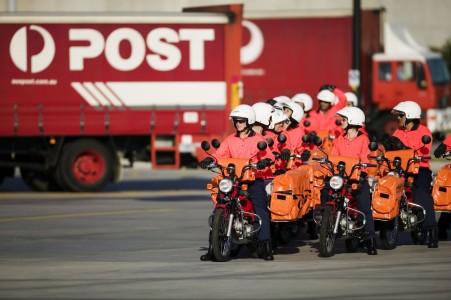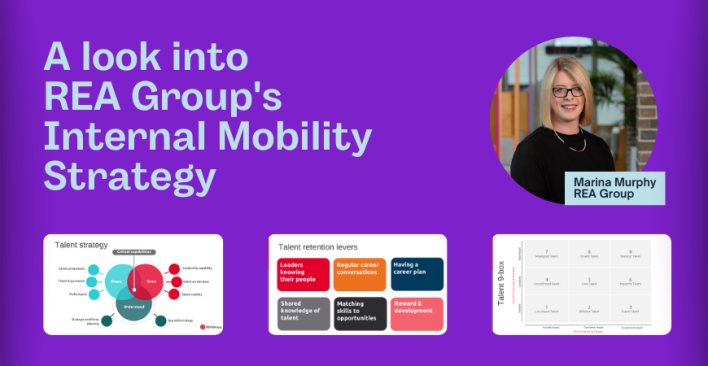How Australia Post Transformed Recruitment into an Integrated Talent Management Machine

Danielle: Rebecca Houghton welcome and thank-you for sharing your story with us today of how you’ve managed to consolidate internal recruitment with talent management at Australia Post – quite a remarkable feat for a fairly traditional organisation.
Could you talk us through what that process involved and your motivation behind the decision?
Rebecca: Thanks Danielle. Gosh where to start? I’ll probably start by saying, that the Post People 1st initiative is a really organic growth story, so being able to start from a place where a decision was made and a perfectly formed strategy was executed would be really misleading. It has been very much part of our change journey, which I will talk more about that at the ATC. If we’re going to become the Australia Post of the future, and leave behind us much more traditional methods of communication, like letters, we’ve got to take our people on a huge change journey and no-one would expect them to be able to do it without significant support.
Post People First is really a raft of creative, innovative ideas that have been put together in a very simple, very purposeful way to help our people transform themselves into the Australia Post of the future.
Danielle: So why is a ‘multi-dimensional recruitment model’ important in the current environment and do you think the classic one-dimensional internal recruitment model dead?
Rebecca: Mmm, what a great question. I’ll start with your last question – yes I absolutely do think just recruitment on its own is dead. Um, I think if you ask most progressive HR leaders the sense of an entire employee lifecycle, that whole employee experience, the employee journey, is absolutely essential to success. If people are our number one asset we’ve got to consider them in a much more holistic manner and I think in order to do that HR has to be much more holistic in its approach.
So going into a world where recruitment stands alone, and talent stands alone, performance, development, L&D etc etc, stands alone means you have a really deconstructed employee experience. And I think one of the things Post People 1st does is really rethink that completely, we have a completely anti-structure approach, so when we talk about integration its interlocking really, it’s not structural, it’s not leader-led, it’s true collaboration. It’s purpose led and because of that it’s even broader than talent, it’s integrating recruitment with L&D, with Comms, with OD and yeah the list goes on and it really depends on what the next best idea is around what Post People 1st should do to support our people. That will determine who we integrate with next.
Danielle: And so what process did you go through to streamline those various functions? (Laughs) That’s probably a very broad question…
Rebecca: Umm, that’s where doing things in such an organic way is incredibly hard. So really the process I’d say that we took was to define a purpose that was so precise and accurate in terms of time, audience and appetite that it was really easy to rally around it and really easy to make decisions. So um, to give you an example, and it’s probably a really bad example so you might want to edit this, um in the army people are trained to make their own decisions so they know precisely why they’re there and what to do, they don’t wait for structure or chain of command to tell them what to do every moment they are in the field. Now rallying around a purpose that is so crystal clear for HR has similarly enabled people to make their own decisions and to give them accountability to not feel they have to check all the time. You know this is something that is about doing the right thing, so you can’t make a big mistake if your ethics are aligned to the purpose.
That’s been incredibly powerful, and we’ve had probably more than a hundred contributors to Post People 1st in terms of its products and services, and innovations, and communications, none of whom are formally part of the project because the formal project team is probably only three people.
Danielle: Right. So for other organisations who may be thinking about going through the same process, what would you say were the biggest challenges or hurdles, or what can they expect to face?
Rebecca: Uh, well working in this organic manner really means people have to let go of structure, get very comfortable with joint accountability and in fact create single accountability for the crowd environment if you like. That’s a really different way of working and I think there’s a challenge just in working differently – (laughs) doesn’t matter what job you’re doing, working differently has challenges. And I think this way of working – this very organic, boundary-less, purpose aligned, as opposed to structure-aligned or leader-aligned, is really different and particularly for organisations like ours where we’re quite a structured organisation, that’s been a major challenge.
I think if we hadn’t have had a purpose that was so super clear, it would have made things very difficult to do. I think if the purpose hadn’t have made the decision-making criteria so obvious or easy to follow, people would have been nervous about taking accountability or taking action without being instructed or being given permission. And I think without that purpose being so clear we wouldn’t have had such viral executive support. The way that this initiative has been absorbed into the language of the organisation, the scorecards of our leaders, the way we are and the things that we do – that was never planned that was really an unexpected outcome of this incredible purpose,and it’s really allowed us to do things quite different.
So if I had to look back on it and say could we have designed for that? If our purpose had have been less accurate, I think it probably would have been much more difficult to do, potentially would have failed or just become really chaotic and unclear and difficult to manage.
Danielle: Have you seen any results of this model or are there any metrics you can share at this stage?
Rebecca: Yeah absolutely. We’re seeing some really early successes, but we’ve got a huge way to go. Post People 1st is only six months old and it’s effectively three things.
One stream is 1st for Jobs, putting together pretty much what every other organisation has and that is an internal recruitment capability – we did not have it.
We now have it and we’re now filling more than 50% of our roles with our internal people. Now if you look at the knock on effect of what that’s done, that’s actually reduced the number of retrenchments that we’re looking at, it’s reduced the numbers of recruits that we have to make. That’s had a huge cost implication and a massive engagement implications so our overall performance improves. I think that sort of illustrates that lifecycle thinking. And it really addresses a number of challenges on all fronts when it could have just been an internal recruitment function.
The other stream is 1st for Skills. That’s where we’re really targeting the roles of the future, both for us and the communities that we serve. What are those jobs? What qualifications and skills do people need to have those jobs? And how will we give them those skills and qualifications? Um, you know that’s a really massive piece of investment that Australia Post has as something that’s quite unique and it’s really growing in its momentum.
We’ve probably trained or qualified 5,000 people at Post in a way that’s potentially changed their career – impacted how employable they are.
The third piece, which is the piece we haven’t launched yet, is 1st for Careers. So that will be a career coaching service, career self-evaluation toolkits and career pathways and those career pathways will be really holistic. We really want people to consider Post as their employer today who invests in them in such a way that they can become more employable, whether it’s with us or somebody else in the future.
We really want to invest in the workforce of the future and we’ll start with ourselves. So those are the three pillars.
Danielle: Going back to one of your earlier points, in terms of one of those pillars, do you think that the paradox of recruiting jobs while making other jobs redundant will be acceptable in the future? It seems to be…
Rebecca: (Laughs) Oh you’ve hit on a personal favourite there! Absolutely not!
I mean one of the really key moments that helped us think up the Post People 1st initiative was that recruitment and transition (our triple R team – our retrenchments team), were separate stand-alone entities a year ago. They came together just after Christmas last year and it immediately became obvious to me and me and my new leadership that we were looking at a balance sheet where we could have a lot of people coming in and a lot of people going out, and that was neither morally nor commercially the right thing to do.
That’s one of the original drivers of the Post People 1st initial idea: if we were able to redeploy people before they became redundant we could save them a whole period of pain and save ourselves significant costs. Much of the best talent for the job is within our own organisation. We’ve got 35,000 people here, and really a huge number of them are very capable of doing the jobs that we offer.
Danielle: Just finally, what are the three key takeaways that you hope delegates will get from your session at the ATC, what do you hope to leave them with?
Rebecca: I think One. Leave with a concept of how you can operate in a really integrated way right across the lifecycle if you have a very clear purpose.
I think another is to perhaps tell the story of what’s happening at Post. A lot of people have perceptions about what Post is all about so I think making sure people are very clear about what the facts are and what the challenges are. A lot of the things we’re doing at Post People 1st, without that context, I think they’re pretty straight forward. In the context of Post they’re a highly, highly complex execution piece. So I think probably those two things.
And I think the third is the real encouragement of people to try and work in a more sophisticated, collaborative manner, to really experiment with the idea of having no structure, no boundaries, no leader on a shared purpose. An awful lot of fantastic outcomes can be generated really rapidly from working in that style so, I’d really want people to give that a go.
Danielle: Rebecca, thank-you it’s been a most enlightening discussion and I look forward to speaking with you at the ATC.
Rebecca: Thanks Danielle, I look forward to seeing you there too.
Rebecca Houghton is the Keynote speaker at the upcoming Australasian Talent Conference, Sydney on 21st May 2014. She will be drawing on this case study to provide lessons and practical take-outs for delegates who may be embarking on a similar process of recruitment simplification. This year’s theme is all about challenging yourself with ‘New Wave’ talent management thinking, with tracks on Simplification, Technology and Analytics. Register here to attend.
Related articles
Leave a Reply
Sign up to our newsletter
Get a weekly digest on the latest in Talent Acquisition.
Deliver this goodness to my inbox!

